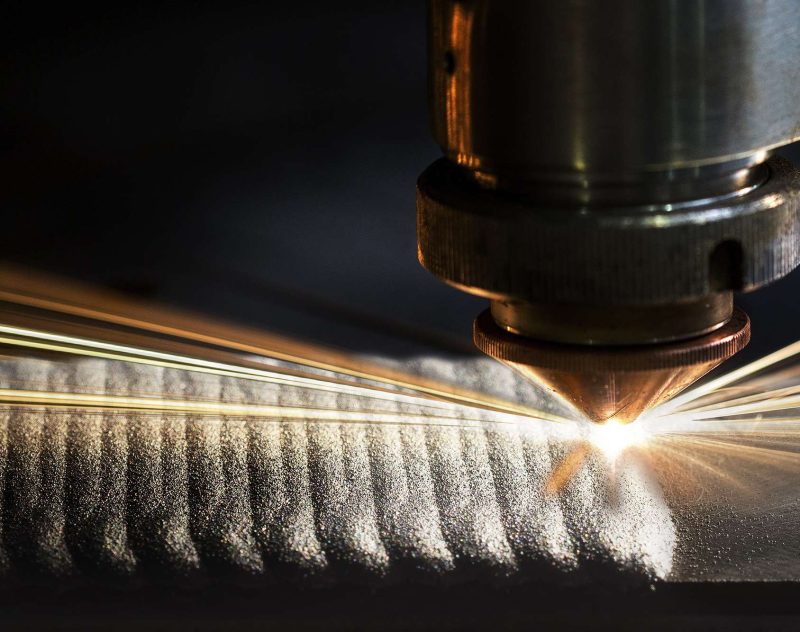
high-speed laser cladding
Laser cladding is a cutting-edge technology that has transformed how we repair and restore components. It is an additive manufacturing process that includes fusing a material layer onto a substrate using a high-powered laser beam. This process helps create protective coatings for better functionality and to restore worn-out surfaces.
The laser cladding process has gained popularity in the aerospace, automotive, and medical industries because of its several advantages. It helps extend the life of machinery and equipment, especially those exposed to wear, impact, and corrosion.
In this article, we will examine the various aspects of the cladding technology, including its benefits, applications, and prospects. Let’s get straight to it!
Laser Cladding Technology
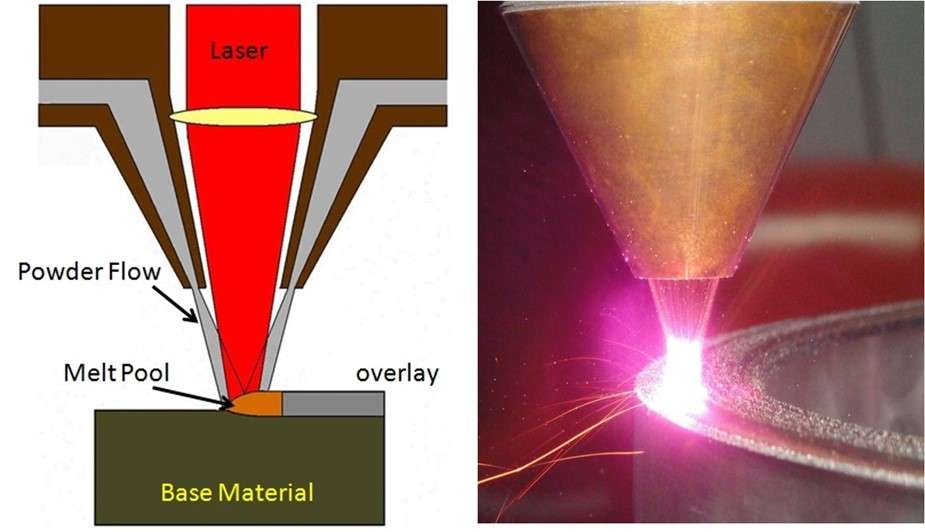
laser cladding on a metal
Laser cladding, or laser metal deposition, is a method for depositing one material on top of another. A stream of metallic powder or wire is fed into a melt pool produced by a laser beam as it scans the sample surface, depositing a coating of the selected material.
Laser technology ensures materials are deposited precisely, selectively, and with low heat input into the underlying substrate. It improves the surface properties of a part, such as wear resistance, and repairs damaged or worn surfaces. One of the most precise laser-clad welding methods is used to create this mechanical bond between the base material and the layer.
Overview of the Laser Cladding Process
Laser cladding is a method of applying a metal coating to the surface of a component using a laser as the heat source. The technique commonly produces a protective coating to improve efficiency and restore damaged or worn surfaces. Laser clad extends beyond machinery and equipment whose components are subjected to corrosion, wear, or impact. For example, the construction equipment industry uses this technology to increase wear resistance and keep equipment in operation for longer.
Usually, a coating is applied to a substrate by melting metallic powder with a laser, such as IPG’s high-power multimode fiber laser. Steel alloy or stainless steel surfaces can be protected with coatings such as tungsten carbide, nickel alloy, or cobalt alloy. The method creates a strong metallurgical bond with a minimum dilution of the base substance, improving metal corrosion, abrasion, and wear resistance.
Types of Lasers Used for Cladding
Different types of lasers are used for the laser cladding process. However, the type of laser depends on the kind of requirements for the cladding process and specific applications. These are some of the common types:
CO2 (Carbon Dioxide) lasers
These gas-based lasers can generate extremely high levels of power. They are commonly used in cladding applications that demand deep penetration. CO2 lasers work by electrically discharging carbon dioxide gas molecules, causing the molecules to emit photons of light at a specific wavelength of around 10.6 micrometers.
Fiber Lasers
They are solid-state lasers that use fiber optic cables as their lasting medium. These solid-state lasers transmit their laser beam through optical fibers. They can provide cladding of excellent quality with a smooth surface finish. Due to their high power output, superior beam quality, and effective operation, these lasers are widely used in several laser-clad applications.
Nd: YAG Lasers
Nd: YAG (neodymium-doped yttrium aluminum garnet) lasers are solid-state lasers and are commonly used in laser cladding. Neodymium-doped yttrium aluminum garnet crystals are used as the lasing medium in Nd: YAG lasers. They can provide a wide range of power densities and have a high pulse repetition rate.
Diode Lasers
These semiconductor-based lasers are usually employed in low-power applications like laser cladding. A p-n junction diode is a more lasing medium.
Related:
How To Choose the Right Laser Cutter for Your Needs?
Materials Used in Laser Cladding
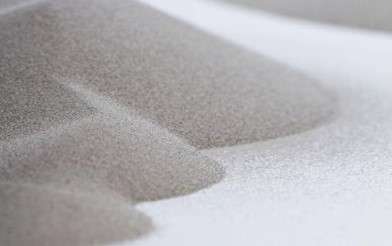
Nickel powder for laser cladding
Laser cladding is a process where a material is melted and deposited on a substrate using a laser beam to produce a coating layer on the material’s surface. Different materials can be used for this process, depending on the qualities needed for coating and the specific applications.
The choice of materials depends on the property of the coating, such as thermal stability, corrosion resistance, and wear resistance. Here are a few laser cladding materials that are commonly used for laser cladding:
- Metal powders. Different metal powders like titanium, aluminum, cobalt-based alloys, and nickel-based alloys are used for the laser cladding process.
- Ceramic powders. For laser cladding, you can also use ceramic particles such as alumina, zirconia, carbide, and tungsten can also be employed.
- Composite powders. Coatings with special characteristics can be made using composite powders, which are made up of a combination of metal and ceramic powders.
- Because of their great hardness and wear resistance, carbides, like tungsten and chromium carbides, are usually used for laser clad.
- Diamond particles. The laser cladding materials may be supplemented with diamond particles to increase wear resistance and decrease friction.
- Laser cladding can make coatings with excellent wear resistance and low friction using polymers such as polyamide.
- Glass powder. Glass powders help to produce coverings with distinctive optical and thermal characteristics for laser cladding.
Advantages of Laser Cladding over Other Coating Technologies
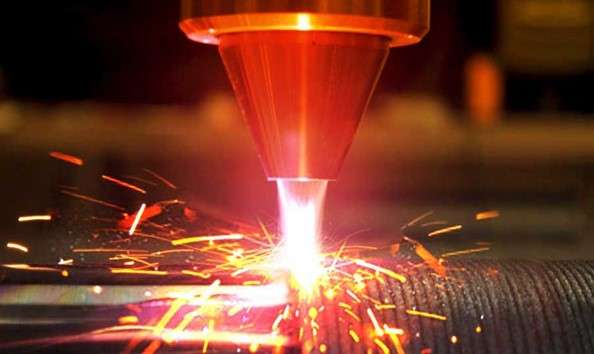
Laser cladding on a metal part
There are numerous advantages of laser cladding over other coating methods. Delivering a better-quality coating material with high bond strength and integrity and improved surface quality are some benefits of laser cladding. Another advantage is its ability to position customized performance-enhancing materials precisely.
Laser cladding can also be used with various materials, including custom alloys and metal matrix composite (MMC) designs, both as the base and the layer. It has little to no porosity (>99.9% density) within the sediments. A small amount of heat is applied, resulting in a small heat-impacted zone (EHLA as low as 10 m). The substrate’s minimal distortion lessens the need for remedial machining.
Simple automation and integration of CAD/CAM manufacturing environments are why laser cladding is preferred over other coating techniques. It requires shorter manufacturing time and enhanced thermal control with the modulated laser output. Laser cladding can improve the functionality of components and also repair damaged components.
Benefit of laser cladding
This surface modification technology is an efficient custom manufacturing process that offers many benefits for several applications. Some of these benefits include the following:
Enhance Durability and Wear Resistance
Laser cladding can improve material wear resistance. This is accomplished by layering a hard substance on a softer substrate. The hard layer acts as a protective coating resistant to abrasive damage.
Increase Components’ Lifespan
Laser cladding can extend their lifespan by improving the surface characteristics of components. This is because the process includes applying a layer of material to a substrate, which can improve the substrate’s resilience to wear, corrosion, and other types of degradation.
Reduce Downtime and Maintenance Costs
Other surface treatment methods, such as plating or thermal spraying, can be more expensive than laser cladding. This is because it needs less material and can be completed quickly.
Improve Component Functionality and Performance
Laser cladding venture uses the process to improve material performance. This is because it can improve the substrate’s characteristics, such as strength, hardness, and toughness.
Environmentally Friendly and Sustainable
Laser cladding can aid in the reduction of material wastage. This is because the procedure only applies a layer of material where it is required. This reduces the quantity of material needed while also minimizing waste.
Applications of Laser Cladding
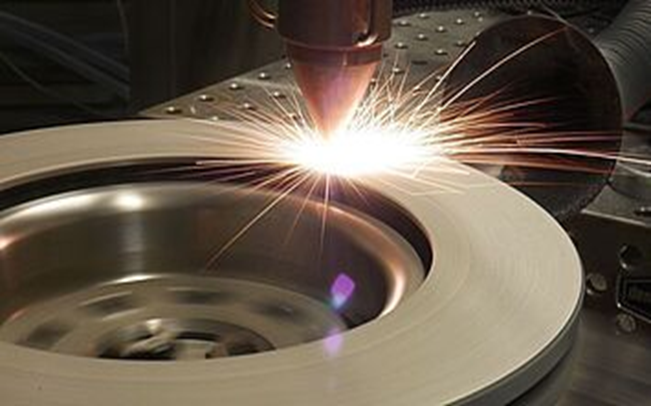
automobile application of laser cladding
Laser cladding is a versatile technology with a wide range of uses. Here are some examples of popular applications:
Restoration of Damaged Components
One of the essential uses of laser cladding technology is restoring damaged components. Laser cladding can help repair damaged or worn sections by adding material to the surface, restoring the component to its original proportions and function.
Surface Modification for Wear Resistance
Manufacturers also use Laser cladding to cover metal pieces with a hard, wear-resistant coating such as hydraulic cylinders, gears, and engine components. The coating may also provide corrosion protection, thereby prolonging the parts’ lifespan.
Creation of Custom Coatings
The process can also transform a part’s surface properties, such as adding a pattern or texture to improve grip or decreasing friction to enhance performance.
Repair of High-value Components
Laser cladding can be used to repair damaged or worn sections by adding material to the surface. This is particularly helpful for expensive or difficult-to-replace parts like molds, shafts, blades, and turbines.
Aerospace and Defense Applications
In the aerospace and military sectors, the laser cladding process helps improve the performance and reliability of components in missiles, aircraft, and other high-performance systems.
Automotive Applications
The automotive industry has several potential uses for laser cladding companies, ranging from improving the performance and durability of engine components to extending the lifespan of high-wear parts.
As a seasoned expert in laser cladding technology, Proleantech offers agricultural harvester parts with laser cladding coatings that significantly reduce wear and tear, leading to longer usage times and cost savings for our clients. If you have a need for such products, please do not hesitate to contact us at any time.
Conclusion
Laser cladding is an efficient method for improving the surface properties of a wide range of materials. This process improves wear and corrosion protection and overall performance by applying a layer of material onto a substrate with a laser beam. This can increase lifespan, lower maintenance expenses, and increase efficiency.
With the laser cladding process becoming more accessible and cost-effective, it becomes more appealing for a wide variety of applications. Contact us at ProLean Tech for the best laser cladding services that meet your unique requirements.




0 Comments